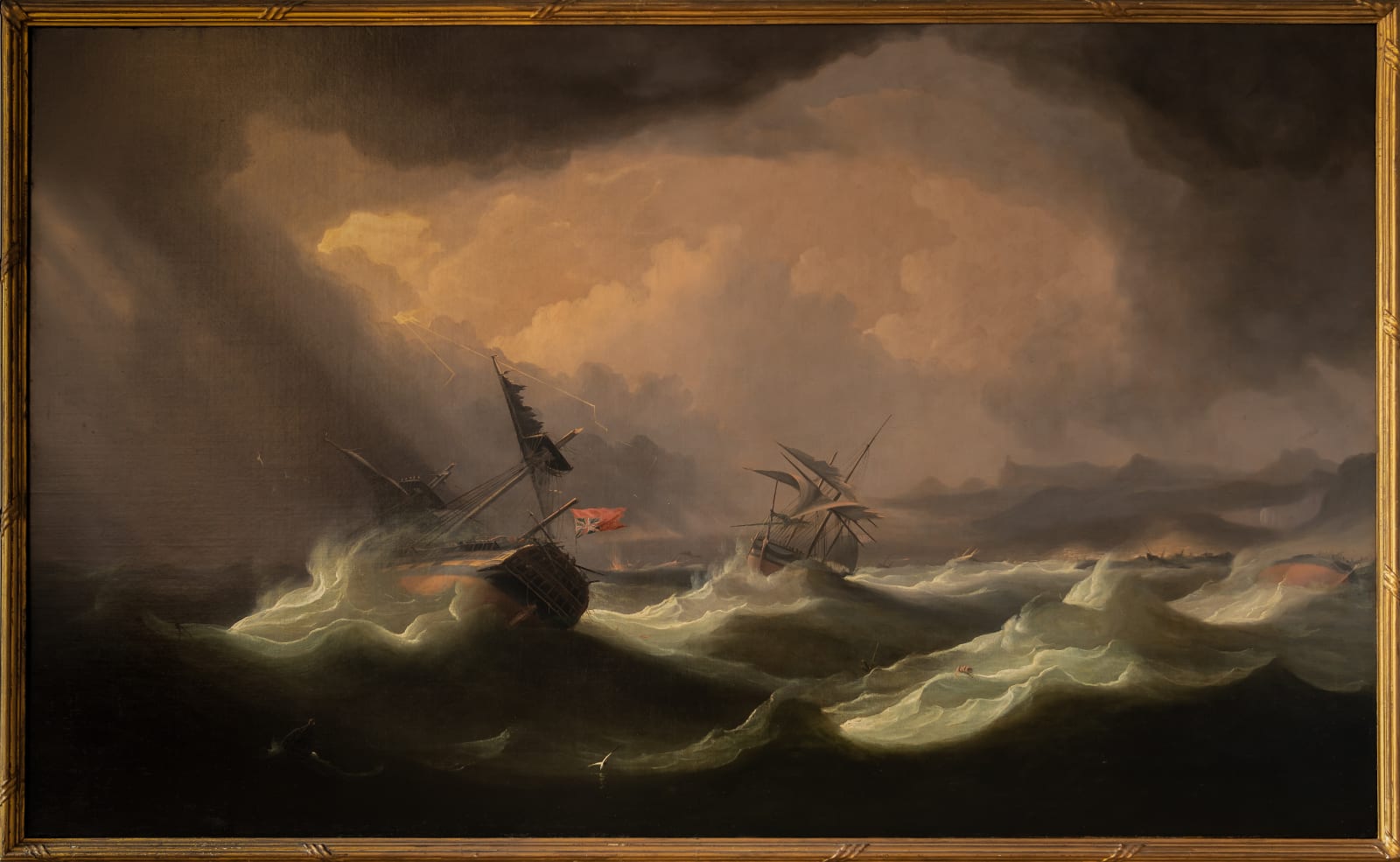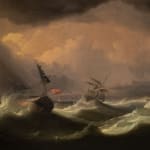William John Huggins 1781-1845
38 x 62 in. (96.6 x 157.5 cm) framed
The oceans of the world have witnessed the disappearance of innumerable fine ships over the centuries, but few are as intriguing as the loss without trace of H.M.S. Blenheim and all those in her including Rear-Admiral Sir Thomas Troubridge, one of Nelson’s immortal ‘Band of Brothers’, in the Indian Ocean in 1807.
After a long and distinguished career, including active service in Indian waters over ten years (1775-85), Troubridge had served with Nelson on several occasions, in fact, culminating in the ‘glorious victory’ at the Nile in 1798 which brought his name to prominence as one of Nelson’s celebrated ‘Band of Brothers’. These men were quite simply the elite of the Royal Navy as the eighteenth century turned so it was no surprise when Troubridge was promoted to Rear-Admiral in 1804 and appointed joint Commander-in-Chief, East Indies, the following year. With most of the Navy’s capital ships engaged to deal with the Franco-Spanish fleet threatening England herself, Troubridge had little choice for his flagship and selected H.M.S. Blenheim, a rather elderly ship-of-the-line launched in 1761 as a second rate mounting 98-guns, but later cut down to a 74-gun third rate. After a spell in the Caribbean, she was recommissioned under Captain Austin Bissell in March 1805 and sailed for Madras on 25th April (1805) flying the flag of Rear-Admiral Troubridge at her main masthead.
The other joint C.-in-C. East Indies was the dashing Sir Edward Pellew, but such was the antipathy between him and Troubridge that the Admiralty very soon rescinded Troubridge’s appointment and new orders followed him out from England to take command at the Cape of Good Hope. Despite some damage to Blenheim when she grounded in the Straits of Malacca in 1806, Troubridge was certain that she was perfectly seaworthy and, in company with H.M.S. Java, a 36-gun Dutch frigate recently captured off Batavia, and H.M.S. Harrier, a small brig-sloop commanded by Edward Troubridge, the admiral’s only son, the ill-fated squadron sailed from Madras on 12th January 1807. Soon after sailing it became apparent that the Java was not in the best of condition, and it is probable that Troubridge was forced to temper Blenheim’s speed in order to allow Java to keep up with the flagship. Whether this was the case or not, progress was good, largely thanks to the prevailing ‘Northeast Monsoon’. There were those who had criticised Troubridge for embarking on the voyage during the winter monsoon season, but the admiral believed the direction of the wind was greatly in his favour and he was, after all, under orders to proceed to the Cape of Good Hope with all possible speed. At the beginning of February however, Troubridge’s luck ran out when his ships were caught in a vicious gale and mountainous seas off the island of Rodriguez, some 350 miles east of Mauritius. It is possible that the admiral mistook Rodriguez Island for Mauritius, but that is only conjecture and is not relevant to the narrative of his loss. Sufficient to say the three ships found themselves on a lee shore and in great distress. After several days of pounding, the Blenheim was dismasted and in a precarious state, so much so that on 5th February she hoisted the recognised signal of distress (the inverted ensign seen at her stern) to indicate she was in danger of foundering. At this point, the Harrier lost contact with the other two and was swept out to sea. In the event, Harrier somehow survived her ordeal, but Blenheim and Java were never reliably seen again.
The captain of a French frigate reportedly sighted Blenheim near Rodriguez “in a heavy gale of wind” on 18th February, but was it her, especially since the Harrier supposedly saw Blenheim in company with Java on 1st March in another “heavy gale” off Mauritius? Other rumours of unidentified damaged vessels off Madagascar and also Reunion Island abounded, but no conclusive information that those ships were Blenheim and Java, with 950 or so men in them, including Sir Thomas Troubridge, one of the ‘Heroes of the Nile’ was ever discovered.
This dramatic work by Huggins, perhaps commissioned by Captain Edward Troubridge of the plucky little Harrier, depicts in graphic terms (from the left) the Blenheim on her beam ends, flying the instantly recognisable signal of distress between her stern and mizzen stump, the Java, fighting to stay afloat under torn canvas and with her topmasts gone and, seen clearly off Java’s stern, the silhouette of a small two-masted vessel under bare poles (surely the Harrier?) attempting, albeit unsuccessfully, to run into Port Mathurin for shelter on the nearby shore. Despite the overwhelming menace of sky and sea, the painting is nevertheless an accurate testament to the last confirmed sighting of Sir Thomas Troubridge’s doomed squadron and thereby laying the mystery to rest.



